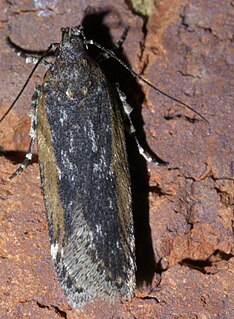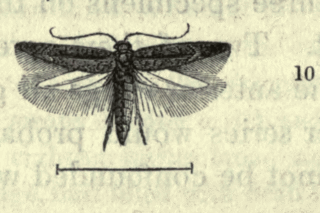Related Research Articles

Dyseriocrania griseocapitella is a moth of the family Eriocraniidae. It is found from Nova Scotia to Florida, west to Illinois and Mississippi.
Merimnetria flaviterminella is a moth of the family Gelechiidae. It was first described by Lord Walsingham in 1907. It is endemic to the island of Hawaii.
Exelastis rhynchosiae is a species of moth in the genus Exelastis, known from Arkansas and Florida in the United States. It is restricted to specific habitats with dry or well drained sandy soils such as pine flatwoods, pine-turkey oak sandhills, sandy open areas of high live oak hammocks, or sand pine-evergreen scrub on ancient dunes where the hostplants grow.
Dyseriocrania auricyanea is a moth of the family Eriocraniidae. It was described by Walsingham in 1882. It is found in California.

Aroga trialbamaculella, the red-striped fireworm moth, is a moth of the family Gelechiidae. It is found in the United States, where it has been recorded from Maine to Florida and from Illinois to Texas.
Exoteleia anomala, the ponderoa pine needle miner, is a moth of the family Gelechiidae. It is found in the United States, where it has been recorded from Alabama, Louisiana, Mississippi, New Mexico and Arizona.
Xenolechia ceanothiae is a moth of the family Gelechiidae. It is found in North America, where it has been recorded from Michigan.
Filatima occidua is a moth of the family Gelechiidae. It is found in North America, where it has been recorded from Washington and California.
Filatima ornatifimbriella is a moth of the family Gelechiidae. It is found in North America, where it has been recorded from Colorado, Arizona, Texas, Nebraska and Illinois.
Filatima tridentata is a moth of the family Gelechiidae. It is found in North America, where it has been recorded from California.
Filatima vaniae is a moth of the family Gelechiidae. It is found in North America, where it has been recorded from Utah and California.
Filatima natalis is a moth of the family Gelechiidae. It is found in North America, where it has been recorded from Arizona, Colorado and Oregon.
Filatima neotrophella is a moth of the family Gelechiidae. It is found in North America, where it has been recorded from Texas.

Filatima pseudacaciella, the dusky-backed filatima moth, is a moth of the family Gelechiidae. It is found in North America, where it has been recorded from California, Illinois, Indiana, Kansas, Kentucky, Louisiana, Maine, Massachusetts, Mississippi, New Hampshire, New York, Ohio, Oklahoma, Ontario, Tennessee and West Virginia.
Keiferia glochinella, the eggplant leafminer moth, is a moth in the family Gelechiidae. It was described by Zeller in 1873. It is found in the United States, where it has been recorded from Texas, New Mexico and California. Records outside the western United States are based on misidentifications.
Gnorimoschema shepherdiae is a moth in the family Gelechiidae. It was described by Ronald J. Priest in 2014. It is found in North America, where it has been recorded from Alberta, British Columbia, Manitoba, Michigan, Quebec and Yukon.

Scrobipalpa instabilella, the saltern groundling, is a moth in the family Gelechiidae. It was described by John William Douglas in 1846. It is found in on the Canary Islands, in Algeria, Ireland, Great Britain, Portugal, Spain, France, Belgium, the Netherlands, Germany, Denmark, Italy, Sardinia, Sicily, Greece, Cyprus and Palestine. It is also present in the United States, where it has been recorded from California.
Syncopacma crotolariella is a moth of the family Gelechiidae. It was described by August Busck in 1900. It is found in North America, where it has been recorded from Florida.
Nealyda pisoniae is a moth of the family Gelechiidae. It was described by August Busck in 1900. It is found in Cuba and the United States, where it has been recorded from Florida.
Tosca plutonella is a moth of the family Gelechiidae. It was described by Carl Heinrich in 1920. It is found in North America, where it has been recorded from New Mexico.
References
- ↑ Adamski, D. ; J.L. Apple & J.G. Bishop, 2009: A new Filatima Busck (Lepidoptera: Gelechiidae) associated with lupine and early herbivore colonization on mount St. Helens. Proc. Entomol. Soc. Washington111 (2): 293-304. Full article:
| Wikispecies has information related to Filatima loowita |
| Wikimedia Commons has media related to Filatima loowita . |
| This article on a moth of the genus Filatima is a stub. You can help Wikipedia by expanding it. |